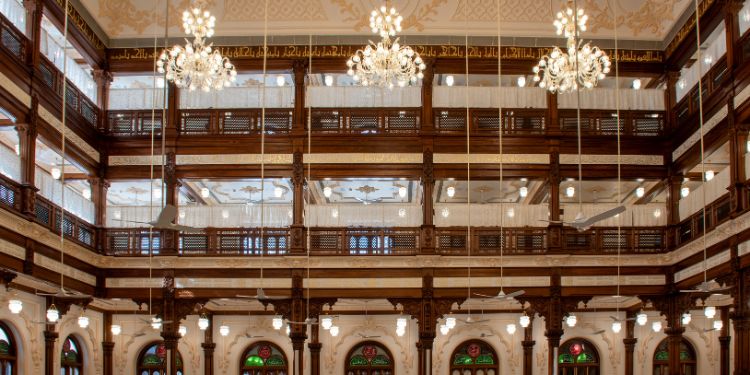Saifee Masjid in South Mumbai’s Bhendi Bazaar simply spells a century of ‘spirituality of a class.’ Originally built in 1926, and renovated in late 2023, the Masjid has come to be reckoned not only for its architectural heritage splendor but also for its ambitiously massive audio-visual systems integration that was synced with its grandiose aesthetics- by the coming together of three leading AV brands in the country: Alphatec, ISSPL, and Play Technologies.
SIAsia presents a snappy account of what has been one of the most massive AV integration projects, which is in turn part of a very massive urban development projects in India.
…………………………………………………………
The Precursor
Saifee Masjid – originally called Ghurrat al-Masjid, to mean the ‘shining mark on the (masjid) forhead’ – appears a veritable phenomenon for its grand Indo-Islamic architectural tenets, nay, the immensity of reverence it commands among the Dawoodi Bohra community.
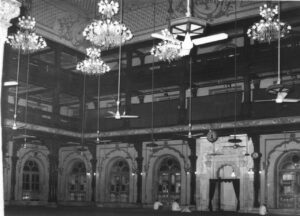
Envisioned and originally built by the 51st Dā’ī al-Mutlaq (most senior spiritual rank and office in Tayyibi Isma’ilism) His Holiness Syedna Taher Saifuddin, the mosque had been a cornerstone for the Dawoodi Bohra Community in India. He chose the spot, and the city for his mission, as it happened to have the highest concentration of the community in the country.
The grand old masjid had all the parametrics that defined the characters of Indo-Islamic cultural and architectural tenets. The design of its minarets and the graceful ornamentations are said to have been derived from the famous Taj Masjid built in 1902 at Morbi in Gujarat- built by the 43rd Dā’ī Syedna Abdeali Saifuddin.
Taher Saifuddin’s son, and successor – the 52nd Dā’ī – Syedna Mohammed Burhanuddin initiated restoration of the entire spread of the complex housing the mosque- as part of the ambitious Saifee Burhani Upliftment Project (SBUT) that was actually aimed at uplifting the community life in entire Bhendi Bazaar area. The initiative was hailed as the largest urban renewal project in the country.
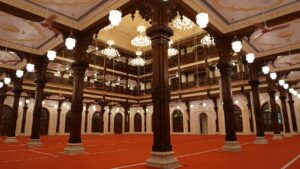
The renovation of the complex meant a truly massive scale of reconstruction, restoring the glory of old structure with high degree of ornamentation that featured extensive use of Burmese teak from the original structure, and opulent chandeliers etc. It measured 34.5 meters in length, 26.7 meters in width, and 15.1 meters in height.
Consider this nutshell:
- The 100-year old majestic (main) mosque, to be capable of accommodating 7,000 worshippers across three levels
- Bab-ul-Futuh, an administrative building, with residential floor for the leader of the sect
- A multi-storeyed, multiuse building with 14 + ground level featuring four multipurpose halls, residences, satellite campus for their university, guest room floors serving as a community hotel for the community’s diverse needs
- A triple-height Ground Floor area, facing the Courtyard, and serving as central gathering space for the community events and socializing
The complex includes a la-Taj Mahal historic structure Raudat Tahera which houses the tombs of three previous leaders of the sect.
The AV Mission
Renovation of the complex meant that besides restoration of old glory, it was to be interconnected through a state-of-the-art, networked Audio and Video infrastructure, enabling seamless transmission of audio and video streams between buildings. This integrated system was to allow effortless sharing of content, facilitating communication and collaboration across the various facilities, including the Main Mosque, Admin building, and the Multiuse building.
This ‘monumental’ task brought to place three, leading, Mumbai-based AV design, supply, and integration majors. Alphatec, Innovative Systems and Solutions Pvt. Ltd (ISSPL), and Play Technologies- to blend their expertise into realizing an ambitious dream and vision.
The preset for design and integration was clear, and arguably massive:
- It had to be an advanced system based on digital platform with backward compatibility and fallback to analog connectivity;
- It had to be easy to use for smaller daily applications and scalable for larger complex events
- Failure of live AV transmission is not acceptable.
- The infrastructure had to incorporate 4K/12G-SDI standards with digital audio.
- It had to provide for additional floating displays, cameras, loudspeakers, microphones at various zones with minimal wires pulled on the floor.
- For daily events the system has to be operable on iPAD while for large events a specialised team would operate the same
- For large events, the speech intelligibility had to be equally superior even as it is aesthetically compatible with sleek look to blend with the interiors.
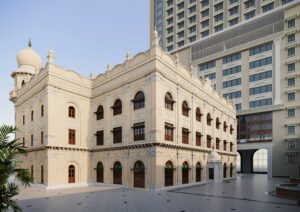
The project was required to deliver seamless AV at all times on the basis of the size of the gathering and location.
Overall, the system was required to be modular, flexible and a scalable infrastructure for AV System which could accommodate increased capacities for larger events, incorporating multiple I/O sources for running as well as redundant solutions.
All this, with safeguarding the aesthetics and heritage value of the structure.
The AV Integration Action
The AV Scale at the Heritage Mosque |
|
|
213 QSC 4.5” zero-bezel loudspeakers 172 Tannoy CMS503ICT LP loudspeakers 91 Lightware encoder/decors 32 Lab Gruppen amplifiers 28 Shure Microphones 25 Blackmagic convertors 23 QSC network expanders
|
21 QSC network wall plates
14 LG LED screens 12 Renkuz Heinz loudspeakers 11 Panasonic PTZ cameras 10 Panasonic projectors 9 Audix microphones 8 dnp Supernova screens (And there are more…) |
A very important aspect of the integration was incorporate a control system which will provide an easy- to-use user interface for admin staff to operate the AV systems. Installed AV to have the functionality of wired and wireless presentation, local reinforcements, unified communication system, multiple recording and streaming to various platforms simultaneously.

“As the Built Contractor, our scope encompassed the entire project lifecycle, from cable laying to final commissioning,” informs Bhavin Sureliya, Chief Operating Officer at ISSPL. “It involved collaborative design-level discussions with consultants and clients to optimize deployment, mitigate potential implementation challenges, and develop a comprehensive project plan.”
The very nature of the structure posed a very potential challenges of scale- of acoustics and aesthetics. The integrator, while ensuring the aesthetic elements are protected, had to conduct rigorous dry runs on the digitally steerable array loudspeakers with various beam level settings. These combined with the SPL levels on the ceiling speakers across the three floors had to be matched so that it is uniform throughout.
The gains had to be adjusted such that 12 gooseneck microphones could be open at the same time without making the system unstable. The wireless microphone system had their antennas distributed throughout the space and on the upper levels so that any microphone could be used within the entire space without any constraints or restrictions.
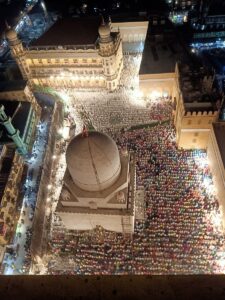
DSP programming was done with an intuitive UI such that the operator can recall the various presets to account for the varying nature of programs. During regular daily event, the system including all microphones are tied to the DSP and driven from it. iPAD-controls and recall of presets made it easy for the users to use the venue without an assistance from the operator.
With a view to enabling the operator to manage the show from the console during large events, a digital mixer was provided in addition to the DSP integration, and all the input sources are available on the mixing console. Use of physical connections and Dante connectivity ensured that the user can move from mixing console to DSP depending on the nature of operation.
Floor boxes were also rendered with Analog connectivity to address any event of network failure.
AVoIP setup connected to the video mixer offered the capability to transmit the video across the campus and into the local venue. The transmission on the displays is through the AVoIP receivers connected to each display or projector.
The provision for 12G-SDI connectivity on floor boxes in the campus area and certain pre-decided locations ensured that the additional cameras installed during large events were connected to the video mixer in the master control room. Fiber extensions were used in case of distances larger than 80 meters.
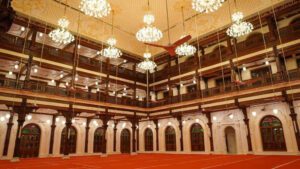
Ambient microphones were placed in the audience area to capture live sound. This was used by the video team to add live effects into their recordings along with the processed sound through DSP and mixing console. This also served as a tool for the operators in the audio control room.
During large events, as the space gets completely filled with worshippers, the operators are unable to go to various areas to check the live sound status. More, the higher floors are reserved for women which makes it even more preventive. This situation is visualized and addressed with ambient microphones- as the operations team is able to hear the real feedback of the sound in various areas allowing them to check if the loudspeaker sound is intelligible.
Seamless control of entire AV system for various areas within the campus had been addressed with Crestron control systems.
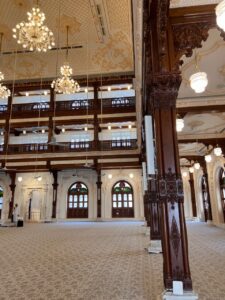
That the transmission points are multiple within the campus it did mean a big job for the operator to manage all. While the Main Mosque itself is formidable, the triple-height area on the ground floor of the multi-use building, the cantilever balcony of the administrative building, from the tomb area of Raudat Tahera, from the multipurpose halls in the multiuse building and the central courtyard- all comprised these multiple transmission points.
The system implementation and the UI/UX controls equip the operators to use any of these transmission areas and relay the same locally using the local reinforcement systems and receive these remotely over AVoIP backbone.
For Audio, the entire backend system was designed using Dante compatible products. The cameras are connected on a 12G-SDI backbone and the video transmission on AVoIP.
The video distribution for reinforcement is completely over AVoIP backbone. The system is flexible to also allow simultaneous events in each of these spaces or group of spaces using a hybrid mix of local and remote content. The provisioning of connectivity points across the campus in wall boxes and floor boxes over network has made this system absolutely scalable.
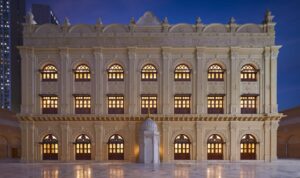
Each building within the campus can be used independently for local events while harnessing the capability of remote transmission/reception to/from any other venue in case of any overflow during the events.
Says an Alphatec spokesperson: “Alphatec’s commitment to excellence has been unwavering from the initial stages of discussion to post-installation support. The seamless pre-sales guidance ensured that the right solutions were chosen, while their after-sales support proved to be reliable and excellent.
Renkus Heinz ICC 12/3 speakers – specializing in beam steering technology – allowed focusing on sound where it is needed. Given the venue’s hosting of 7000 people, these speakers were the perfect choice to be added to the wooden pillars of the Masjid.
Further, the Tannoy CMS Series speakers installed at various places completely blend into the space, especially the lobby area with a clear speech delivered all around.
Overall, the Saifee Masjid is a grand heritage phenomenon relived via AV.











